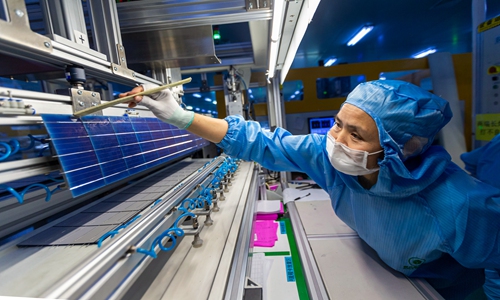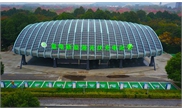SOURCE / INDUSTRIES
China’s photovoltaic exports to see demand postponed into H2

A staff member at a factory in East China's Jiangsu Province works on a photovoltaic product for export after resumed work. Photo: cnsphoto
The ongoing spread of the global pandemic has seen no signs of casting lasting shadows over China's photovoltaic industry. Industry insiders believe that export demand will not disappear but rather be postponed from the first half to the second half of this year.There are rising concerns that the export of photovoltaic products in 2020 may decrease or slow, as the epidemic is becoming serious in some countries where China's component exports are concentrated, such as the Netherlands, Spain and Germany.
Zhen Zhen, a person close to Yingli Solar, China's leading photovoltaic maker, told the Global Times on Monday that in the worst epidemic-hit EU countries, such as Germany, Spain, France and the Netherlands, the free movement of people is already having an impact on installations, but the demand is still there.
"Some organizations, including the German photovoltaic association, have called for a delay in the connection of photovoltaic projects to the grid and an increase in the total number of photovoltaic installations throughout the year to stimulate economic development," Zhen said, adding that it is expected that photovoltaic demand in the first half of the year will be postponed to the second half.
During the epidemic, Yingli Solar's main customers all worked from home, but communication with our order department was still normal. "Currently, we are adjusting our sales strategy to deal with the market changes," Zhen said.
However, given that up to 70 percent of China's photovoltaic products depend on exports, if the epidemic continues to spread abroad, it will affect the construction schedule of overseas photovoltaic projects, a person surnamed Ru with the China Photovoltaic Industry Association also told the Global Times on Monday.
The impact of the overseas epidemic on photovoltaic projects will be seen in the decrease or slowdown of downstream demand, as well as project promotion, finance, and the supply chain, industry analysts said.
Ru also noted that photovoltaic companies should pay special attention to trade friction between the EU and China. "In 2019, it was normal trade. In 2020, if affected by the epidemic, countries will have considerations based on their own interests," he said.
In 2019, China's exports of components reached 66.6 GW, accounting for 67.5 percent of total output, according to the China Photovoltaic Industry Association.
The top 10 importers of Chinese components in 2019 included the Netherlands, Japan, India, Australia, Brazil, Spain and Germany, accounting for 70.2 percent of total exports.

